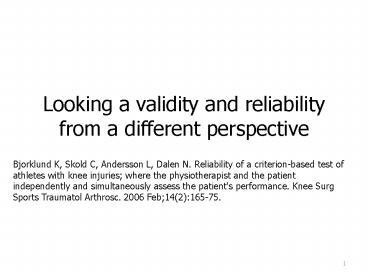Looking a validity and reliability from a different perspective
1 / 13
Title:
Looking a validity and reliability from a different perspective
Description:
Bjorklund K, Skold C, Andersson L, Dalen N. Reliability of a criterion-based ... How do you assess functional ability with Anterior Cruciate Ligament (ACL) injuries? ... –
Number of Views:81
Avg rating:3.0/5.0
Title: Looking a validity and reliability from a different perspective
1
Looking a validity and reliability from a
different perspective
- Bjorklund K, Skold C, Andersson L, Dalen N.
Reliability of a criterion-based test of athletes
with knee injuries where the physiotherapist and
the patient independently and simultaneously
assess the patient's performance. Knee Surg
Sports Traumatol Arthrosc. 2006 Feb14(2)165-75.
2
What about validity and reliability from an
athletic training/ physical therapy perspective?
- How do you assess functional ability with
Anterior Cruciate Ligament (ACL) injuries? - gtBjörklund et al. 2006 proposed a series of tests
to assess functional ability ("Tests for Athletes
with Knee-injuries, or TAK") - TAK is composed of 8 different tests patient is
scored on his/her ability to perform these tasks
(pg 168) - e.g. I Jogging straightforward
- II Fast running straightforward
3
Study Design
4
How did the evaluations work?
5
Reliability, objectivity, validity
- Fundamental questions they wanted to ask were
- How was reliability of TAK assessed?
- This was done a number of ways
- How was validity of the TAK assessed?
- How was objectivity assessed?
- Also, how did the test rate with 1,2,3?
6
How was reliability assessed?
- Scoring of the 59 subjects by Physiotherapist A
and Physiotherapist B - Watched participants go through TAK test at the
same time - Physiotherapist A repeated 31 of the subjects 4-6
days later - Subjects rated themselves on the two different
occasions (n 31) - Physiotherapist A compared to subject
self-assessments (n 59)
7
Reliability Assessment
- Kappa (K) statistic measure of inter- and
intra-rater reliability - Criteria lt0.20 poor
- 0.21 0.40 fair
- 0.41 0.60 moderate
- 0.61 0.80 good
- 0.81 1.00 very good
- Spearman's Rho (rs)
- Correlation coefficient based on rankings
- Don't worry about the details of the calculation
interpret the same as a Pearson r
8
Kappa Statistic (briefly!)
- Measures the stability of an evaluation
9
Reliability of TAK assessed by Kappa Statistic
- Ability of 2 raters to give the same score is
moderate - Reproducibility of a score when separated by 4-6
days is moderate - Ability of a subject to reliably rate his/her
performance is fair
10
Reliability of TAK assessed by correlation
- When assessed by correlation
- 2 raters more reliably assign a score than 1
rater can score the test twice - Trained raters are more reliable than the
participants
11
Validity of TAK?
- Assuming that Biodex is an acceptable measure of
functional ability for the knee - The relationship between TAK and Biodex only
explains 37 of the variance
12
Objectivity of TAK?
- Inter-judge perhaps, but not intra-judge
assessed! - In order to assess intra-judge objectivity,
raters would have to observe the exact same
performance by the subject - Did not happen in this case the 2nd assessment
was the participant repeating the test - Can you be certain that subjects were able to
re-produce the tests the same each time? - Only way to assess objectivity would be to have
videotaped the performances that way there is no
possibility that the inability of the subjects to
reproduce their performance is an issue
13
Overall
- Was reliability truly assessed?
- Physiotherapist A vs. B on same performance may
be a mix of administrator error and test error - Physiotherapist A. vs. A error may be partially
the test administrator error and the inability of
the athlete to re-produce his/her performance - Was validity assessed?
- Yes, assuming isokinetic quadriceps strength is a
valid tool - Was objectivity assessed?
- Inter-judge, yes
- Intra-judge, no































